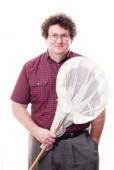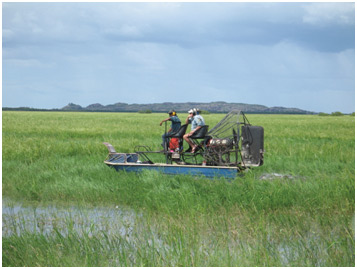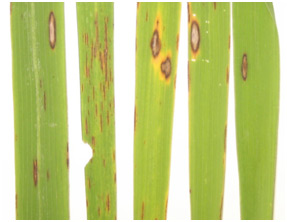Complete
There are two important reasons why pests including Emergency Plant Pests (EPPs) can become established in urban areas and spread to nearby horticultural or agricultural areas. First, urban dwellers usually purchase large quantities of goods and services from a variety of sources and locations, and so are potentially exposed to a wide a range of pests. Second, urban areas have a high density of exotic gardens and other resources that allow newly introduced pests to become established. Surveillance for EPPs in urban areas is therefore an important element of any system that aims to prevent the establishment of pests in rural and agricultural areas.
Research outcomes
This project looked at the contribution that passive and targeted (or active) surveillance can make to the on-ground management of Emergency Plant Pests (EPPs). EPPs can become established in urban areas and spread to nearby horticultural or agricultural districts. Surveillance for EPPs in urban areas is an important element of any system that aims to prevent the establishment of pests in rural and agricultural areas.
The benefits of a combined program of targeted and passive surveillance for an EPP was investigated. A combination of targeted and passive surveillance has kept the European wasp — a major pest of urban areas and horticulture in south-eastern Australia — from establishing a viable population in Western Australia for the last 30 years.
Targeted surveillance using lures and passive approaches relying on public reporting are complementary techniques that can prevent establishment and spread of European wasps.
Research implications
This project illustrated that a multi-pronged surveillance approach may be needed to control the spread of EPPs — in this case study, infestations of the European Wasp in Western Australia (WA).
For more than 30 years the Department of Agriculture and Food of Western Australia (DAFWA) has been using a combination of passive and targeted surveillance techniques to detect and then destroy wasp nests to control the European wasp.
A major challenge for the surveillance program is that if a nest is missed during one summer it may overwinter allowing the release of new queens. The population of wasps and their colonies can therefore exhibit explosive growth within a single summer.
Additionally, with hibernating wasp queens being continually imported into WA from rail or road transport freight there is an ongoing need for this cost effective surveillance program to continue.
Standard use of GPS devices (in Personal Digital Assistants or other hardware) would reduce the time required for data cleaning and manipulation and facilitate faster, more prompt analysis of surveillance data sets.
Acknowledgements
Thanks to Darryl Hardie and Fred Ramsden from DAFWA and the staff from the Pest and Disease Information Service (PaDIS).
PROJECT DETAILS
Complete
Budget
$55,000
PROGRAM DETAILS
CORE CRC PARTICIPANTS
The objective of CRC40035 was to review the process of moving emergency plant pest (EPP) samples during incursion, determine critical control points to manage risks and make recommendations for R&D. This review does not include samples collected by the Australian Quarantine and Inspection Service (AQIS). Management of these was being reviewed internally.
There are two main groups of plant related diagnostic samples that could contain EPPs:
- Biosecurity samples generated by surveillance, emergency response, eradication and containment programs.
- Routine samples collected by farm consultants and primary producers to facilitate efficient farm management and access international markets.
Sample types vary widely and include herbaceous and woody plants, fruit, hay, seed, insects and soil. Each type of sample has specific packaging requirements for it to survive transport intact and arrive in good diagnostic condition.
Research outcomes
Australia Post currently only require packaging for plant diagnostic samples to comply with standard parcel post, although restricted samples need to conform to the respective State Quarantine regulations and be accompanied by Plant Health Certificates (Post Guide, Parcels within Australia, 2005). The requirements for parcel post is expressed in outcome terms e.g. must not leak etc, but do not have minimum technical specifications.
Better guidelines should be developed for the different types of plant, insect and soil samples to minimise the risk of substandard packaging being used. The recommended packaging must be readily available and reasonably priced if it is to be widely adopted.
New standards should be recorded in PlantPlan and updated as required. Incursion, eradication and containment programs are obliged to use the protocols in PlantPlan. PlantPlan is also readily accessible by diagnostic laboratories. User friendly brochures could be developed for primary producers and consultants, citing PlantPlan as the reference, and promoting biosecurity in the process.
Setting packaging standards too high will discourage people from sending samples. There are significant benefits to be achieved by encouraging people to send samples to approved laboratories; these include increasing the chance of early detection of EPPs and improved farm efficiency. By comparison, the risk they pose to spreading EPPs is very low, especially when compared to other means of dispersal.
Research implications
The CRCNPB is in a unique position to make a useful contribution to developing practical packaging standards and streamlining delivery of plant diagnostic samples. The following areas need to be addressed:
- The decision to include plant infectious agents in AS 4834 was made with limited industry consultation and needs to be reviewed. Using Category A for samples that may contain EPPs will delay setup times and increase the cost of the incursion, eradication and containment programs, and associated research programs. The current definitions also encompass routine samples and this is likely to have an adverse impact on demand.
- If AS 4834 standards are endorsed, then suitable packaging for each sample type needs to be identified and made available in regional areas.
- If AS 4834 is considered excessive, then the standard will need to be revised, and new standards developed based on readily available components. These standards could be included in PlantPlan or developed as new categories in AS 4834.
- Contingency plans should be reviewed to ensure they include detailed packaging specifications and appropriate suppliers.
- To simplify the process of sending samples, endorsement should be sought from State Quarantine Authorities to remove the requirement for Plant Health Certificates or Written Approval notices to accompany samples sent in recommended packaging to approved laboratories. This will encourage agricultural consultants and producers to submit more diagnostic samples, and increase the chance of early detection of EPP incursions and farming efficiency.
Acknowledgments
- Australian and Australian/New Zealand Standards
- Australian Dangerous Goods Code (ADG Code)
- Department of Health and Ageing
- Australia Post Guides
- Department of Transport and Regional Services
- Department of Agriculture, Fisheries and Forestry (DAFF)
- Biosecurity Australia; Plant Biosecurity
- Australian Quarantine and Inspection Service (AQIS)
- Plant Health Australia
- NSW Department of Primary Industries
- Department of Primary Industries and Fisheries; Biosecurity
- Grow Help Australia
- Primary Industries and Resources South Australia
- Department of Primary Industries and Water; Biosecurity, Tasmania
- Department of Primary Industries, Victoria; Biosecurity Victoria
- Department of Agriculture and Food, Western Australia
- Western Australian Quarantine Inspection Service (WAQIS)
PROJECT DETAILS
Complete
Term
November 2006 - June 2007
Budget
$55,000
PROGRAM DETAILS
This project aimed to develop cost-effective, readily adoptable alternatives to a phosphine fumigant that will control resistant insects and comply with industry and market standards.
Research outcomes:
- Establish rate of desorption of air from grain under nitrogen.
- New knowledge of insect response (toxicity, behavioural) to low O2/high N2 concentrations and its relationship to phosphine resistance.
- New knowledge of the effects on grain quality of storage under nitrogen.
- New nitrogen application method.
Research implications:
This research has led to development of cost-effective, readily adoptable phosphine alternatives that will control resistant insects and comply with industry and market standards which significantly contribute to further enhance Australian grain industry reputation in both domestic and international market.
Acknowledgements:
The authors would like to acknowledge the support of the Australian Government’s Cooperative Research Centres Program. The support from the CRC for National Plant Biosecurity (CRCNPB), Murdoch University and the Department of Agriculture and Food, Western Australia (DAFWA) is gratefully acknowledged. We thank Dr Pat Collins, Dr David Eagling, Dr Jonathan Banks, Ern Kostas, Greg Hopkins, Matthew Head and Chris Newman for their helpful advice on research and trial protocols. We thank CBH and Doug Clarke (Western Australia Grains Group, Lake Grace) for their assistance with the procurement of wheat, canola and storage facilities. We thank also Doug and the Clarke family (Western Australia Grains Group, Lake Grace), Ern Kostas, Graeme George, Nicholas Trim and Keith Andrews (CBH) for assistance in the conduct of the trials. We thank Professor Cao Yang and his team (Stored Grain Research Lab, Chinese Academy of Cereal Science) for assistance in laboratory bioassays and conduct of the trials to test membrane separation nitrogen generator in horizontal wheat storage.
Publications:
Alternatives to Phosphine - Final ReportPROJECT LEADER

Dr YongLin Ren
Project Leader CRC50147: Low oxygen technology for alternative to phosphine
y.ren@murdoch.edu.au
Phone: 08 93601397
Read More
PROJECT DETAILS
Complete
Term
May 2009 - May 2012
Budget
$927,130
PROGRAM DETAILS
CORE CRC PARTICIPANTS
This project has assisted participating industries prioritise management strategies in response to invasive species incursions. It is expressly designed to be as adaptable to the circumstances of biosecurity risk management decisions as possible (i.e. in terms of the time frame of the decision, available scientific information and data, and diversity of the decision-making groups).
It built on the success of the Cooperative Research Centre for National Plant Biosecurity (CRCNPB) project CRC10010 “Enhanced Risk Analysis Tools” (ERAT) by developing more effective communication software devices for use in decision-facilitation forums. It utilised the technologies produced by ERAT and other CRC projects, as well as recently-developed techniques of connecting dispersal models with spatial grids (e.g. Rafoss, 2002; Harwood et al., 2010).
Research outcomes:
Our research has demonstrated the usefulness of two broad analytical tools: maps-based incursion response tools, and; statistically-based economic impact models.
We have successfully demonstrated the potential for maps-based incursion models to be used to communicate complex suites of information to industry and government stakeholders. These models can be used in conjunction with decision-trees and multi-criteria analysis to form a structured decision making (SDM) approach to refining invasion response plans. This process can be facilitated by using the maps-based models to simulate different invasion scenarios which a decision-making group must then manage in a ‘war-gaming’ experiment. In this way, response tactics, logistics and flexibility can be tested before an invasion event. When a real event does take place, the lessons learned in the war game experience can be put into practice.
We have also demonstrated the explanatory power of more traditional, statistics-based economic impact assessments in communicating the potential significance of EPPs over long periods of time (e.g. 20-30 years). These assessments can be of great strategic significance in setting broad research agendas and funding priorities when site-specific details of possible future incursions are not relevant.
Research implications:
The research carried out by the CUBA project team implies that important steps could be taken to refine incursion response strategies, and that the techniques currently exist to facilitate this. Moreover, with careful planning, a range of complex information about invasive species impacts, uncertain information and expert testimony can be utilised in a structured and sequential way to facilitate management decisions that are mutually acceptable to all stakeholders within a decision-making group.
Technologies such as keypad devices and interactive decision-making software continue to be developed that make capturing and processing decision-maker thoughts and preferences quick and easy. With appropriate application and training for prospective users, these technologies could greatly enhance decision-support processes for biosecurity risk managers in the future. In this project, we have demonstrated that group-based decision facilitation techniques that provide a structural framework for making invasive species management decisions can be very effective. They can facilitate negotiation and sharing of knowledge between stakeholders, and add an important element of transparency.
This is particularly true when decision-support frameworks can be built around maps-based incursion projection technologies. When a decision-making group is placed psychologically ‘near’ to an event, pictorial representations of it are more effective decision aids than words and statistics. Spatial, maps-based models can be used to simulate incursion events before they actually occur so that risk managers can practice and refine response protocols. Being maps-based, the outputs of these simulation models are relatively easy to interpret and contextualise, particularly when the decision-making group is familiar with the map onto which incursion information is projected.
Spatial models may one day form the basis of ‘live’ control centre operations where a real incursion is tracked as it occurs. Technologies such as hand-held diagnostic tools and smart traps may one day be integrated with these spatial models to update them as information becomes available. This could potentially form a platform around which management decisions could be quickly formulated and tested by projecting EPP abundance and distribution before they are put into practice.
Acknowledgements:
The Communicating Uncertainty in Biosecurity Adaption project team would like to acknowledge the fantastic support we have received from Apple and Pear Australia Ltd. and the Australian Banana Grower’s Council. We are very grateful for the valuable role participants in our Expert Reference Group workshops played in shaping the project and the spatial incursion management model. Thank you also to all who participated in the final project workshop held in Melbourne on the 19-20 April 2012, including Annie Farrow, Jesse Reader and Sarah Kulman (Apple and Pear Australia Ltd.), Michael Crisera (Fruit Growers Victoria), Lucy Gregg (Fruit Growers Tasmania), Susan Finger (Victorian Farmer’s Federation), Simon Mills (SPC Ardmona Ltd.), Steven Field, Olivia Montecillo, Brendan Rodoni, Bill Washington, Martin Mebalds, Chin Gouk and David Williams (DPI Victoria), Anne Mooney (DPI New South Wales), Kim James, Brad Wells and Brad Mills (Horticulture Australia Ltd.), Timothy Coutts and Rose Hockham (Department of Agriculture, Fisheries and Forestry), Stephen Dibley (Plant Health Australia), Jim Cullen (CRCNPB), Andre Drenth (University of Queensland), Peter Merriman (Peter Merriman Consulting), Fiona Macbeth (Blackwood and Kemp Pty. Ltd.).
We would also like to thank Paul De Barro, Andy Sheppard, Robyn Noel, Dean Paini, David Adams, Stephanie von Gavel and Rieks van Klinken (CSIRO Ecosystem Sciences), Simon McKirdy, David Eagling, Scott Baxter, John Austen, Max Knobel and Andrew Crichton (CRCNPB), Richard Maxwell (DPI Victoria), David Peasley (David Peasley Horticultural Services), John Thomas (University of Queensland), Jim Pekin (Australian Banana Grower’s Council), Rob Fraser (University of Kent), Roman Carrasco (National University of Singapore), Jeff Waage (London International Development Centre), Matt Thomas (Penn. State University), Richard Baker and Alan MacLeod (Food and Environment Research Agency), John Mumford and John Knight (Imperial College London), Rachel Meldrum (CRCNPB and Northern Territory Department of Resources), Andrew Tomkins (Northern Territory Department of Resources) and Victoria El Zein (Park Royal Hotel) for their valuable help at different times during the project and in preparing publications.
PROJECT LEADER

Dr David Cook
Project Leader CRC10162: Communicating Uncertainties in Biosecurity Adaption (CUBA)
david.cook@agric.wa.gov.au
Phone: 02 6246 4093
Fax: 02 6246 4000
Read More
PROJECT DETAILS
Complete
Institution
CSIRO Ecosystem Sciences
Term
April 2010 – June 2012
Budget
$691,289
PROGRAM DETAILS
CORE CRC PARTICIPANTS
SUPPORTING CRC PARTICIPANTS
Risk is divided into two categories: likelihood of an event occurring and the consequence once the event has occurred. In biosecurity, the likelihood of an event (i.e. a species invading Australia) can be further divided into the likelihood of arrival, establishment and spread with entry (arrival) and establishment being the two key components. CRC10001 has been using artificial neural networks (i.e. Self Organising Maps – SOMs) to estimate likelihood of establishment. However, this only addresses only one half of the entry/establishment likelihood equation.
The second half is the likelihood of entry and in an increasingly connected world, trade and trade paths are increasing exponentially. Ships that arrive into Australia may have visited multiple ports before arriving. These complex pathways present opportunities for pests and pathogens to arrive at Australia from indirect routes. For example, the Khapra beetle incursion in Western Australia in which this beetle was found in the personal effects of a family emigrating from Scotland. These personal effects had become contaminated when transferred into a shipping container that had originated in Pakistan. This highlights the fact that simply monitoring those pathways that directly link Australia to countries in which a pest or disease is found may not significantly reduce the likelihood of an incident.
Research outcomes:
Models developed in this project, which enable the analysis of complex shipping networks, provide a significant step forward in the risk profiling of incoming ships to Australian ports. These models enable the identification of pathways of greatest threat from invasive species as well as those Australian ports most likely to receive these invasive species.
Research implications:
These models could be incorporated into the current inspection protocols and enable further refinement and prioritisations for these procedures.
Acknowledgements:
Simon Barry, Peter Caley, Paul De Barro, Tom Harwood, Greg Hood, Rieks Van Klinken, Denys Yemshanov.
PROJECT LEADER
Dr Dean Paini
Project Leader CRC10161: Six degrees of preparation
dean.paini@csiro.au
Phone: 02 6246 4178
Fax: 02 6246 4000
Read More
PROJECT DETAILS
Complete
Term
February 2010 – February 2011
Budget
$267,780
PROGRAM DETAILS
LOCATION
CORE CRC PARTICIPANTS
Plant nematology as a discipline is in a state of depletion in Australia at present, yet nematode pathogens cause losses of at least $450 million per annum in Australia and US$120 billion each year in crop losses worldwide.
There are some serious emergency nematode pathogens, such as the potato cyst-nematodes (Globodera rostochiensis, G. pallida), and stem nematodes (Ditylenchus dipsaci), and their presence is a quarantine issue and a non-tariff barrier to trade. In the past three years several additional species of root-lesion nematode (Pratylenchus spp) have been found in Western Australia (WA). The cereal cyst nematode (Heterodera avenae) is now known to be much more widely spread in WA than previously thought. The root-knot nematode Meloidogyne fallax has recently been detected in WA, and related species such as M. artiellia are serious problems in chickpeas grown in the Mediterranean region where new germplasm is often collected for Australian crop improvement. Climate modelling also indicates that many nematode pests of Mediterranean, sub-tropical and tropical regions would survive well if introduced into Australia.
What is the biosecurity problem?
In order to improve Australian biosecurity against new incursions of nematode pathogens, it is essential to conduct a risk analysis, to assess potential agricultural and horticultural zones at risk.
There is also a need to have improved technologies available to detect, identify and eliminate exotic plant parasitic nematodes. This will enable potential new incursions to be predicted, controlled, and a thorough knowledge of nematode issues will also promote Australian trade and market access through high quality evidence-based support of phytosanitary issues and regulations.
The main outputs of this project were to:
- train an individual to the PhD level in plant parasitic nematode biology, risk assessment and taxonomy
- train an individual to the PhD level in classical and molecular diagnostics of plant nematode pathogens
- develop and validate new high throughput nematode diagnostic techniques for surveying and monitoring the presence of nematode pathogens
- provide a trained individual with expertise and understanding of plant biosecurity issues, who can take on a leadership role in this area of biosecurity of soil-borne pathogens, and
- develop a faster detection techniques such as MALDI-TOF MS
Who are the end-users of this research?
Personnel without nematode knowledge, Australian Quarantine Inspection Services officers and the agricultural industry in general.
The Estonian translation of this page is available here.
STUDENT
PROJECT DETAILS
Complete
Supervisor
Professor Michael Jones (Murdoch University) and Dr Vivien Vanstone (Department of Agriculture and Food, Western Australia)
Supervising Institution
Murdoch University
Term
August 2009 - June 2010
LOCATION
The traditional research disciplines underpinning plant biosecurity are the plant protection fields of entomology and plant pathology. However, plant biosecurity is more than just pathology and entomology it also encompasses issues such as mathematical risk analysis, social aspects of risk, emergency response planning, invasion biology and quarantine processes.
In order to ensure the next generation of plant biosecurity researchers are fully equipped to respond in an appropriate and timely manner to biosecurity issues in the agricultural sector this projects has developed a national postgraduate curriculum in plant biosecurity.
Research Outcome
The postgraduate curriculum includes a Postgraduate Certificate, Postgraduate Diploma and coursework Masters as a way of allowing entry into the field by people with no first degree but relevant professional experience (Postgraduate Certificate), or with a first degree in a relevant field (Postgraduate Diploma and Masters). Such an approach allows the greatest opportunity for practitioners seeking professional qualification and advancement. Our proposal does not cover PhDs in biosecurity, which are research degrees already available through any Australian university with staff competent to supervise in the field.
The project has developed new collaborative arrangements between universities, which allow the teaching of specialist degrees for which no one university may have the required expertise. The university consortium developed for this project consists of Charles Darwin University, La Trobe University; Murdoch University, Queensland University of Technology and the University of Adelaide.
Working together, the universities have developed, and are delivering, postgraduate training in plant biosecurity. Specifically, and as of the start of 2010, it is now possible to undertake flexibly delivered units. These units can be undertaken on a full-time or part-time basis and are designed to align with work place requirements. Information on the courses can be found at www.plantbiosecurity.edu.au
Research implications
Formal, tertiary level training in plant biosecurity is now available in Australia. This is important for lifting the standard of plant biosecurity in Australia, and for ensuring international best practice.
Acknowledgements
The Universities of the Plant Biosecurity Curriculum would like to acknowledge the funding provided by the Australian Government Department of Education, Employment and Workplace Relations through the Collaborative and Structural Reform Grant (CASR) scheme. The Australian Government Department of Agriculture, Fisheries and Forestry, through the Office of the Chief Plant Protection Officer, also made significant contributions to the project through the in-kind and operating support of Dr Glynn Maynard. The Department of Innovation, Industry, Science and Research supported the curriculum project through the Australian Government's Cooperative Research Centres Program.
PROJECT LEADER

Dr Anthony Clarke
Project Leader CRC60047 - T: A National Postgraduate Curriculum for Plant Biosecurity
a.clarke@qut.edu.au
Phone: 07 3138 5023
Read More
PROJECT DETAILS
Complete
Term
January 2007 - June 2010
PROGRAM DETAILS
CORE CRC PARTICIPANTS
SUPPORTING CRC PARTICIPANTS
Previously there were no guidelines for people to transport plant, soil and insect samples into and between laboratories. With the move to include harmful pests and diseases in the United Nations regulations, protocols for biosecure packaging needed to be developed that were acceptable to all relevant stakeholders, and enable the safe, swift and legal transport of plant, soil and insect samples nationally and internationally.
Research outcomes
The outcome of this research was that there are suitable packaging products readily available from supermarkets, Australia Post and commercial packaging suppliers that can be used to provide effective and secure packaging of the full range of potential diagnostic samples. Protocols for biosecure packaging have been developed that use products that are readily available, conform to International Air Transport Association (IATA) specifications, and maintain integrity of sample contents when posted or couriered between laboratories.
Research implications
These packaging protocols are relevant to the movement of both routine diagnostic samples and quarantine samples for diagnosis, both domestically and internationally.
The recommended packaging methods could be used as a basis for sending and receiving all samples and be provided by receival laboratories as a best method for packaging.
There is the potential for streamlining sample movement between laboratories by alleviating some of the paperwork required providing assurance that the samples will arrive complete and in a suitable condition.
Acknowledgements
Nancy Kelly, Dominie Wright and James Cunnington for participating in the survey of posted packaging. Jan Gooden for all her help and information from the first phase CRC40035.
PROJECT LEADER
Ms Barbara Hall
Project Leader CRC40121: Biosecure packaging
Barbara.Hall@sa.gov.au
Phone: 08 8303 9562
Fax: 08 8303 9393
Read More
PROJECT DETAILS
Complete
Institution
South Australian Research and Development Institute (SARDI)
Term
April 2009 – Sept 2010
Budget
$176,880 (cash and in-kind support)
PROGRAM DETAILS
LOCATION
Phosphine is the main fumigant used in Australia to control insect pests in grain storages; both bulk grain handlers and farmers rely on phosphine for the control of insects and more than 80% of grain is fumigated with phosphine during storage.
However, insect resistance to phosphine is increasing in most grain growing areas. To manage this resistance, a rapid and sensitive method for identifying phosphine resistance is required. The current detection method for phosphine resistance relies on time-consuming laboratory bioassay procedures (more than seven days required). A previous study (Park et al., 2008*) had suggested that certain proteins, displayed by two-dimensional electrophoresis (2D-PAGE), from whole Rhyzopertha dominica, differed between resistant and susceptible insects and might be developed as a rapid diagnostic tool.
Research outcomes
This project initially aimed to identify the genes encoding those differing proteins as a first step towards developing a diagnostic tool. However, when the project team used a larger number of strains of R. dominica and a more robust method the results of the previous study were not supported. The project team then proposed that this approach to biomarker discovery might yet be successful if they were to concentrate a more appropriate subset of proteins for proteomic analysis.
Various lines of evidence suggested that mitochondria are a site of important differences associated with phosphine resistance. A proteomic comparison of mitochondrial proteins from susceptible and resistant Tribolium castaneum (chosen for its completed genome sequence) was therefore conducted. The study did not reveal any significant differences in the expression of the more abundant mitochondrial proteins between resistant and susceptible insects. The aim of identifying differentially expressed proteins that are diagnostic for phosphine resistance has been shown to be beyond the scope of this project.
Research Implications
No changes to the use of phosphine for fumigation nor the management of resistance can be recommended as a result of this work.
Acknowledgements
David Schlipalius and Pat Collins (Queensland Primary Industries and Fisheries) supplied some of the insect strains.
*Park, B.-S., Lee, B.-H., Kim, T.-W., Ren, Y.L., Lee, S.-E., 2008. Proteomic evaluation of adults of Rhyzopertha dominica resistant to phosphine. Environmental Toxicology and Pharmacology 25, 121–126.
PROJECT LEADER
PROJECT DETAILS
Complete
PROGRAM DETAILS
CORE CRC PARTICIPANTS
Rice blast, caused by Magnaporthe grisea, is generally considered the most important disease of rice worldwide because of its extensive distribution and destructiveness under favourable conditions. South-eastern Australia is the only rice-growing area in the world free of this disease. M. grisea can infect and produce lesions on all parts of the plant and the fungus can infect rice plants at any growth stage.
A rice blast model developed earlier and run for the period 1988-1999 with the meteorological data of four representative locations in the Australian rice growing area highlighted the potential threat of rice blast to the Australian rice industry. Out of a possible 11 years run in the model, the number of years favourable for outbreaks of blast ranged from two at Griffith to nine at Yanco.
Research outcomes
Surveys were conducted in 2006 in the flood plains of the Adelaide and Alligator Rivers at the end of each wet season using airboats to access flooded remote regions. In 2007, similar areas were surveyed together with the Mareeba wetlands in northern Queensland and various Oryza populations in the Kununurra region of Northern Territory. Disease lesions on leaves of wild rice were collected and treated by standard plant pathology methods to isolate causal organisms on agar for later identification. Pathogenicity tests on cultivars of domestic rice (O. sativa) were conducted at Charles Sturt University, Wagga Wagga, New South Wales.
Although many samples displayed leaf lesions very similar to those reported to be caused by the blast fungus Magnaporthe grisea, no conidia resembling this pathogen were observed on field material and the fungus has not been isolated from any lesion type. Three fungal genera, Bipolaris, Curvularia and Nigrospora have been isolated from leaf lesions and identification is in progress together with pathogenicity testing. A previously unreported smut disease of wild Oryza spp. has been identified as a Tilletia species new to science. It appears to have some negative effects on the physiology of domestic rice. Four bacterial pathogens of rice, Pantoea ananatis, Acidovorax avenae, Burkholderia cenocepacia (possibly B. gladioli) and B. cepacia, were found consistently associated with diseased flag, sheath and node lesions.
Research implications
The incidence of blast in northern regions should pose no threat to the domestic rice industry. Further testing of the pathogenicity of the new smut fungus to domestic rice cultivars should be a matter of high priority.
Acknowledgments
Considerable assistance was given to the planning and execution of the project by Dr Penny Wurm, Charles Darwin University, without whom the sampling would have been more difficult and restricted in locality.
Dr Roger Shivas, DPI, Qld, identified and described the new species of smut fungus.
Dr Karen Gibb, CDU, provided laboratory space for isolations in 2006 and Jane Ray, pathologist with AQIS, NT, provided laboratory space and logistics in 2007.
Dr Andrew Mitchell, NAQS, NT, and Drs Carol and Lindsay Campbell University of Sydney, confirmed Oryza identifications.
Tracey Vinnecombe, Agriculture WA, assisted greatly with a survey of the region north of Kununurra in 2007.

Access to the flood plains was achieved by using airboats

Disease symptoms commonly found on Oryza spp in 2006
PROJECT LEADER
PROJECT DETAILS
Complete
Institution
Rural Industries Research and Development Corporation
Term
May 2006 - November 2007
Budget
$53,794 (cash and in-kind support)


















